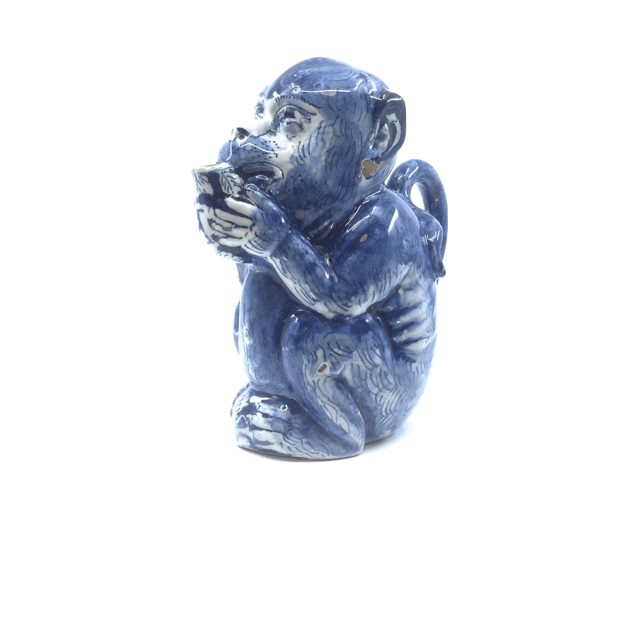
[popup_trigger id=”13756″ tag=”span”]![]() [/popup_trigger]
[/popup_trigger]
Images on this website are licensed under a
Creative Commons Attribution-NoDerivs 3.0 Unported License.

OBJECT
•D1977. Blue and White Jug in the Form of a Seated Monkey
Delft, circa 1775
Marked N in blue
With fur, facial features and limbs finely delineated in blue, and modeled in a tucked position with his elbows resting on his raised knees, clutching in both forepaws a jug inscribed A, possibly for azijn (vinegar) and raising it to his mouth to form the spout, his tail looped to form a handle.
Height: 14.3 cm. (5.6 in.)
Provenance: Salomon Stodel Antiquités, Amsterdam, 1986; Dutch Private Collection
Note: The exotic and often comical monkey jugs, frequently intended as milk jugs with cheerful inscriptions on their bellies, enjoyed great popularity in Dutch Delftware. Originally modeled after Chinese famille verte enameled biscuit porcelain wine ewers from the Kangxi period (1662-1722), many variations in coloring, decoration and inscriptions exist in Dutch Delftware. In the Ming dynasty novel, The Journey to the West, the character Sun Wukong (Monkey) gains immortality by eating peaches that had ripened for three thousand years from the Peach Banquet intended for the Eight Daoist Immortals. The Delft potters, unaware of the allegorical meaning of the fruit, often replaced the peaches with a cup from which the monkey sips. They also often placed the animals on a rock work base and moved the opening from the back of the neck to the top of the head, adding either a tricorn hat with an elaborate stopper or just a simple flat cap. The present example is however more rare than the more Western modeled monkey milk jugs, since it is closer to the Chinese porcelain ewers. It might have functioned as a vinegar jug, and may have formed a pair with a similar jug for oil, thus serving as an amusing condiment set.
Similar examples: A monkey shaped milk jug marked for Jan Pennis, the owner of De Porceleyne Schotel (The Porcelain Dish) factory (1724-1764), in the collection of the Gemeentemuseum, The Hague, is illustrated by Van Aken-Fehmers 2001, p. 120, no. 4. Another unmarked but dated example is illustrated in Van Aken-Fehmers 1999, p. 260, no. 102; another similar jug is illustrated ibid., p. 265, no. 107. Eight further jugs in the Lavino Collection are illustrated in Lavino, pp. 27-28; and one in the Rijksmuseum, Amsterdam is illustrated in Van Dam 2004, p. 176, ill. 120. Two further examples are illustrated in Aronson 2010, pp. 36-37, nos. 15 and 16.
AVAILABILITY
Sold








